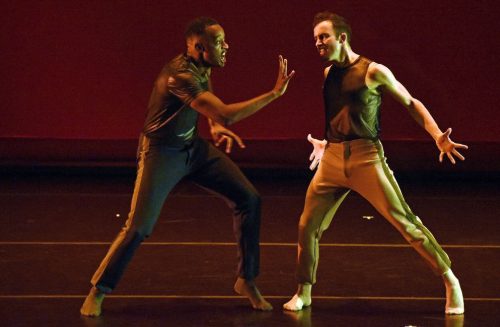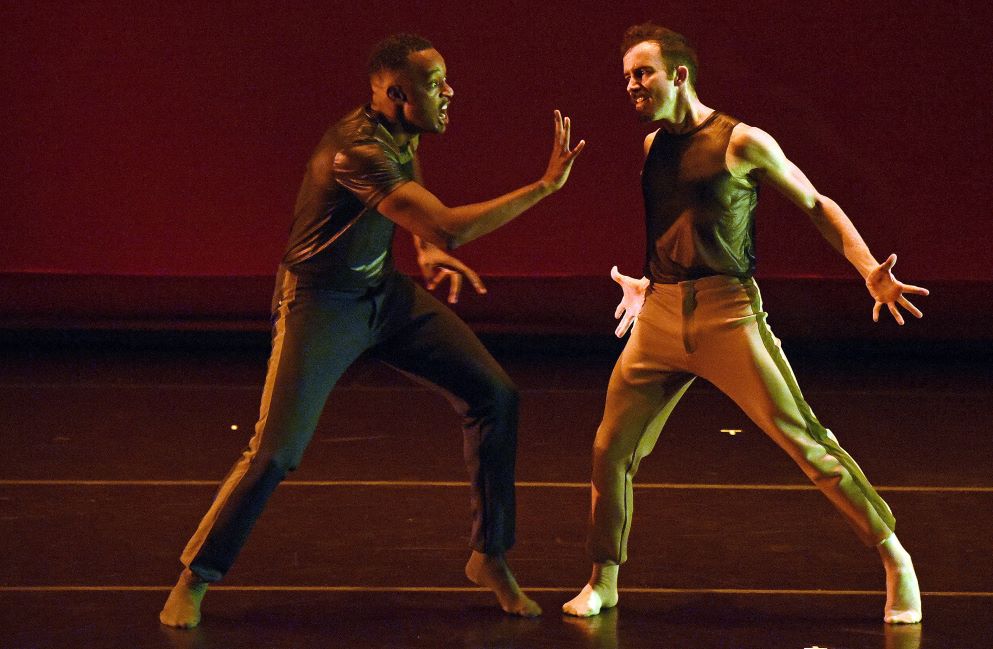 United States BODYTRAFFIC: Dancers of BODYTRAFFIC, Wallis Annenberg Center for the Performing Arts, Beverly Hills, 28.9.2019. (JRo)
United States BODYTRAFFIC: Dancers of BODYTRAFFIC, Wallis Annenberg Center for the Performing Arts, Beverly Hills, 28.9.2019. (JRo)

(d)elusive minds
Choreography and Sets – Fernando Hernando Magadan
Music – Schubert
Music and Sound Edition – Fernando Hernando Magadan
Composition – Fernando Hernando Magadan and Harmen Straatman
Text – Inspired by All the stories by Gora Garcia’s Inserts in Real Time
Lighting – Peter Lemmens
Snap
Choreography – Micaela Taylor
Music – James Brown
Original Music and Sound Edition – SCHOKE
Lighting – Burke Wilmore
Costumes – Kristina Garnett and BODYTRAFFIC
Resolve
Choreography – Wewolf (Rubberlegz and James Gregg)
Music – DJ Tennis
A Million Voices
Choreography – Matthew Neenan
Music – Performed by Peggy Lee; composed by Robert Sour & Una Mae Carlisle, Johnny Mercer & Harold Arlen, C. Farrow, Irving Berlin, Mike Stoller & Jerry Leiber, Adrian Zing & Benny Goodman, Arthur Hamilton
Lighting – Burke Wilmore
Costumes – Company
Dancers – Tina Finkelman Berkett, Ethan Colangelo, Joseph Davis, Haley Heckethorn, Tiare Keeno, Myles Lavallee, Guzmán Rosado, Rachel Secrest, Jamal White
BODYTRAFFIC, though a relatively young company, once again delivered a seasoned, experimental and thought-provoking program. Small in size but mighty in intent, the dancers of BODYTRAFFIC, as Company-in-Residence at the Wallis Annenberg Center, have the technical mastery to deliver a variety of styles from hip-hop to ballet to the dance drama exemplified in [d]elusive minds.
An obscure and often baffling exploration of the mind of a schizophrenic patient by choreographer and director of Nederlands Dans Theater 2, Fernando Hernando Magadan, [d]elusive minds was performed with theatrical flair and fierce commitment by Guzmán Rosado and Tina Finkelman Berkett. In one brief tableaux after another, often using spoken word, snippets of stories and scenes from movies such as Sunset Boulevard and Psycho or TV’s Lucy and Ricky, the couple gesticulated, posed and danced before what looked like a snowbank of crumpled paper, lit from within by a glowing orange light. The threat of domestic violence loomed over all, ending in the death of the female partner. Unfortunately, the difficulty in following the emotional life of the patient made for an ultimately unsatisfying experience.
Snap, by up-and-coming LA choreographer Micaela Taylor, was a wild ride of a dance – controlled yet free, predictable yet surprising. To the music of James Brown, the ‘Godfather of Soul’, the dancers, with Taylor in the lead, exploded into a series of virtuoso hip-hop movements. Settling in for the fun, I thought this would be more like a music video or a night at the Grammys, but it instead became deeper and truer. As Brown’s familiar songs were edited and overtaken by David Schocke’s soundscape of grunts and grumblings, industrial noise, motorcycle rumblings and the spoken words of Brown and the company, the choreography grew darker – the familiar moves of hip-hop merging with a more classically based vocabulary. Circling back on Brown’s songs then devolving again into the sounds of the street, Taylor managed to project a sense of the inner world of Brown, acknowledging the traumas of his early life plagued by poverty, abandonment and imprisonment. Taylor was a galvanizing presence throughout with her long limbs and elastic line. Burke Wilmore’s lighting design aptly handled the darks and lights of Brown’s music and Taylor’s choreography.
Resolve, danced superbly by Joseph Davis and Guzmán Rosado, was an exercise in geometry, a foray into the physics of bodies balancing in space and a seamless partnership that turned two individuals into one. The choreographers of the duo known as Wewolf combined numerous dance disciplines, including urban, ballet and contemporary, to create a singular movement style to the percussive music of DJ Tennis. Body parts took on new meaning as limbs wrapped around torsos or arms became enmeshed in the crook of a knee. The dancers produced a veritable cats-cradle of body positions to achieve a symbiotic pas-de-deux.
The program concluded with the delightfully profound A Million Voices by Matthew Neenan, performed here last year and previously reviewed. It’s a treasure worth repeating and BODYTRAFFIC embraced it in all its humor, irony and sensuality, danced to a soundtrack of Peggy Lee’s marvelous renditions of American popular songs. Neenan’s creation evoked the song and spirit of the Depression era dance hall to the golden age of the Hollywood musical to the propaganda infused tunes of World War II and ended with the brilliant ‘Is That All There Is?’ Like Twyla Tharp, Neenan managed to graft a joyful, contemporary style onto ballet’s underlying structure. This is a dance perfectly suited to the energy and spirit of BODYTRAFFIC and could well serve as their signature piece, the coda to a stimulating evening.
Jane Rosenberg
